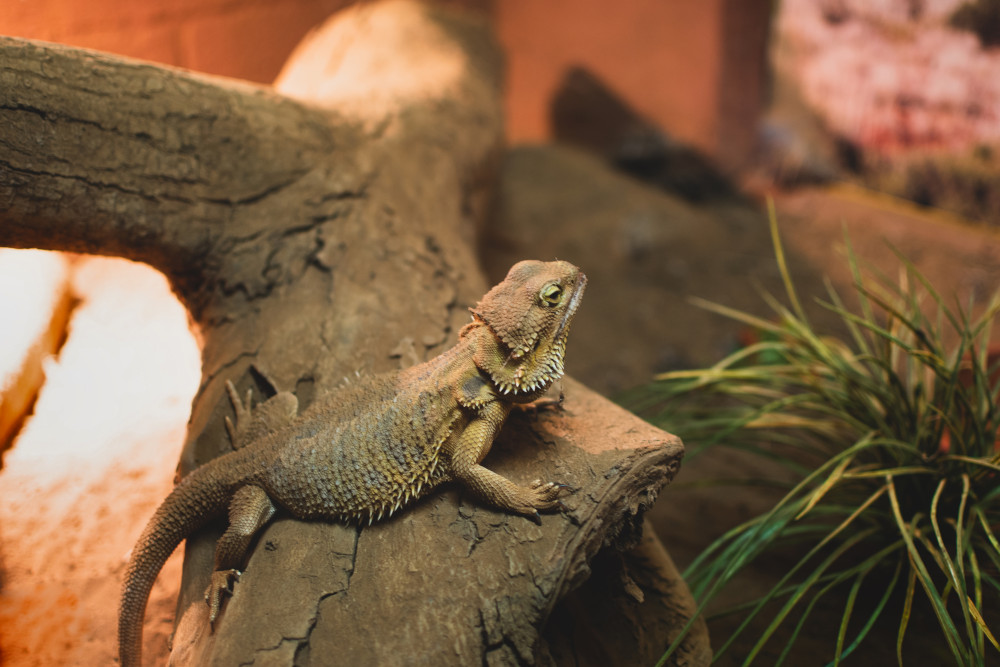What should I feed my reptile?

Reptiles have evolved in many climates and localities, resulting in large variations in dietary requirements. Their dietary needs also vary greatly depending on species, size, and their state of maturity. As a general rule, reptiles can be herbivores (eats mainly or only plants), omnivores (eats plants and animals), or carnivores (eats mainly or only animals).
Snakes
There are no herbivorous snakes; they are all carnivorous. In captivity, mammalian prey items (usually thawed frozen rabbits, rats, and mice) are fed, even though some of the more commonly kept reptile species feed on reptiles in the wild. Snakes will usually readily accept mammals, especially if this is the only food provided from hatching. Only humanely killed prey should be fed (see below).
Nutritional disorders are rarely reported in snakes as they are generally fed a whole prey item, which is usually a nutritionally complete package for a snake. Overfeeding leading to obesity is a common problem in snakes.
The prey item fed should be approximately equal to or slightly greater than the diameter of the snake at the level of their stomach. Python hatchlings will eat small pinkie mice. As a snake grows food items offered should be larger (pinkie -> fuzzy -> weaner mice -> adult mice -> rats).
Feeding frequency will depend on the species of snake, their age and reproductive status. Some species are more active and feed more frequently; for example, tree snakes, whereas pythons feed less frequently as they are less active (they are known as ‘ambush predators’ – they lie in wait for their food). Juvenile animals need to feed more frequently because of their increased growth requirements (hatchlings are generally fed every 4-5 days). Larger snakes are, depending on their size, fed every 1-2 weeks and even as little as every 1-3 months in some circumstances (e.g., overweight snakes, during winter brumation, gravid snakes).
Lizards
Every day reptile vets around Australia deal with lizards suffering from malnutrition-related issues. Remember, malnutrition means ‘bad nutrition’, so it doesn’t just mean not feeding enough food, or nutrient-deficient foods. It also means feeding too much food, food with a excess of nutrients, or an imbalance in nutrients. Getting your lizard’s diet right is absolutely essential for their health and wellbeing.
Lizards can be classed as herbivorous, omnivorous, or carnivorous, with the vast majority being omnivorous. Research is still lacking on the natural diets of some captive species. There may also be seasonal variation of dietary choices, which should aim to be replicated in captivity. Knowledge of the lizard’s natural diet is essential. As lizards are often more active (hunter predators) than snakes, they are fed more often; small lizards need to eat every one to two days, while adult lizards are usually fed every 2-3 days.
- Bearded dragons start as insectivores, later developing a taste for vegetables and some fruits. As adults they can be fed approximately 60% invertebrates (mealworms, crickets, wood cockroaches) and 40% vegetables (leafy greens, mixed vegetables and fruits, squash, peas, beans).
- Blue-tongues begin life as insectivores and snail eaters, gradually becoming more omnivorous in their feeding habits as they mature, eating approximately 50% vegetables, 25% fruits and 25% invertebrates (mainly snails – making sure they have not been exposed to snail baits). They will also eat tinned dog food, but this should be limited due to its fat content.
Note: there are welfare and ethical considerations with the feeding of live insects to reptiles to think about; for more information, see this article.
Insects are low in calcium and vitamin A and some, like mealworms, can be high in fat. It is important to feed the insects on a good diet (see below) and do not overfeed your lizards with them. Obesity is also a common problem in lizards, largely a result of overfeeding combined with the reduced activity resulting from too small an enclosure.
Generally, the size of the prey item should be no larger than the distance between the lizard’s eyes. Insects not consumed in one sitting should be removed as some are known to inflict bites.
Turtles
Australian turtles are predominantly omnivorous, although long-necked species are more carnivorous than the short-necks. Most juveniles tend to be carnivorous but consume a higher proportion of plant material as they mature.
Nutritional imbalance and disease can result if your turtle is fed on only meat or fish diets; multivitamin and calcium supplementation must be provided if they are offered a lot of these food items.

This turtle was fed a calcium deficient diet and this has cause shell abnormalities – the shell is half-sized, domed & distorted.
Vegetables such as leafy greens, parsley, squash, carrots, and broccoli can make up 50%-90% of the diet of most turtles, although long neck turtles prefer a more carnivorous diet.
Animal protein sources include invertebrates (including frozen bloodworms, earthworms, crickets, and mealworms), humanely killed whole fish and fish pieces e.g., marinara mix (rinsed to remove salt). Cat and dog foods can have particularly high fat and vitamin D3 contents and should be avoided or only fed occasionally. Commercial turtle flakes (rich in dried shrimp) may lack vitamins and minerals.
Adult semi‐and aquatic chelonians should only be fed two to four times a week, depending on species and life stage, as obesity is common.
Many semi‐aquatic species will not eat unless they are fed in water. It is recommended to use a separate feeding tank to avoid soiling the main tank with uneaten food.
Feeding mammals
All mammalian prey items should be fed as freshly and humanely killed or “frozen/thawed.” It is extremely stressful to a rodent to be placed in an enclosure with a snake, and no avenue for escape (as there is in the wild). Live rodents are very capable of inflicting severe, often fatal, injuries on a snake as the snake tries to eat the rodent.
So, for animal welfare and health reasons, there are no circumstances that justify feeding live rodents to snakes.
Note: laws relating to the feeding of live prey to reptiles vary in different states and territories and live feeding of vertebrates (includes mammals, birds, reptiles, amphibians, and fishes) is prohibited in some jurisdictions – see this article for more information.
Feeding invertebrates
The most commonly fed invertebrates – crickets, mealworms, super meal worms, and ‘woodies’ (wood cockroaches) – can be readily purchased in pet shops. They need good care before feeding them to your lizards to convert them into a more balanced food item. The feeder invertebrates are best fed a formulated diet that is fortified with calcium and vitamin A, often known as ‘gut loading’. Much of the calcium in the insect diet is not absorbed from the gastrointestinal tract so, with a short gut transit time, the insects need to be eaten by the lizard within an hour of the insects being fed.
Note: there are welfare and ethical considerations with the feeding of live insects to reptiles to think about; for more information, see this article.

Mealworms.
Water
Water is essential for the life of reptiles and should always be provided. Although their thickened skin reduces evaporative loss, there still is a marked loss of water via the skin in many species of reptiles. It is essential that the water is potable and that the water bowl is cleaned or replaced daily (or more often as the animal uses it as a bath).
Reference
Kischinovsky M, Raftery A, Sawmy S (2017) Husbandry and Nutrition. Reptile Medicine and Surgery in Clinical Practice.
RSPCA Australia believes that captive-bred wild animals should not be kept in a home environment or for companion purposes unless the species has been clearly identified as being suitable for this purpose. It is important that animals living in a home environment can live a good life. This means providing for their physical health and ensuring opportunities to fully express their individual interests and experience good welfare. Inadequate care and husbandry are reported to contribute to common and serious welfare compromises in many captive wild animals living in home environments. For more information see our policy.
The reality is, however, that captive-bred wild animals are kept in home environments despite sometimes not meeting these criteria (e.g., some reptile and bird species). Because of this, the RSPCA has produced these articles on the care and welfare of a variety of commonly kept captive-bred wild animals. The aim is to help people better understand their animals as individuals and provide them with care that keeps them healthy and provides opportunities for positive mental experiences as much as possible in captivity.
Wild animals must not be taken from the wild to be kept as companion animals (pets).
Was this article helpful?
This work is licensed under a Creative Commons Attribution-NonCommercial-NoDerivatives 4.0 International License.



